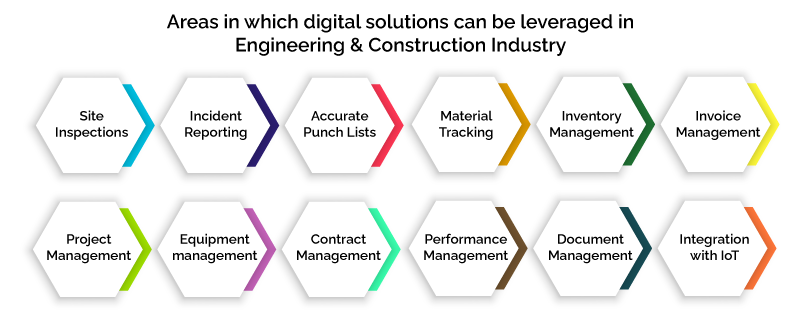
As per PwC – Global Construction 2030, the volume of construction output will grow by 85% to $15.5 trillion worldwide by 2030, with three countries, China, the US, and India, leading the way and accounting for 57% of all global growth. Digital Transformation in engineering and construction industry is undergoing a substantial shift.
Though there are many expectations for the construction sector’s growth rate, the industry has been somewhat slow in adopting digitalization and is lagging behind many other industries. As per a McKinsey report, the construction industry is ripe for disruption. Large projects across asset classes typically take 20 percent longer to finish than scheduled and are up to 80 percent over budget.
The engineering & construction projects involve many activities on the field and in remote places, sometimes without access to the Internet. The projects suffer from a lack of access to real-time data from the field and a lack of coordination between the field workforce and office staff.
Digital Transformation in Engineering and Construction Industry
Digital Transformation in the Engineering and Construction Industry refers to the adoption and integration of innovative technologies, such as Building Information Modeling (BIM), artificial intelligence (AI), Internet of Things (IoT), and automation, to modernize traditional processes, streamline operations, enhance collaboration, and optimize project outcomes. This transformational shift aims to revolutionize how engineering and construction projects are planned, executed, and managed, ushering in a new era of efficiency and effectiveness in the industry.
Also read: Business process management – The what, why, and how
There is immense opportunity to improve efficiency, reduce costs, and speed up project timelines by adopting digital solutions. Given the extensive fieldwork involved in the business, the industry requires that most digital solutions be available through smartphones and tablets.
Digital Solution Use-Cases in Construction & Engineering Industry

Thorough site inspections
The conventional form involves managing information available in books, spreadsheets, or e-mail by dedicated resources. On the other hand, site inspection apps help the on-field workforce inspect the site and digitally capture and store information. This minimizes delays in the process and helps in seamless communication with the stakeholders. Dynamic inspection forms can be created with photographs of the sites inspected along with the signatures of the site in charge and the site inspector.
Prompt safety incident reporting
With safety being a crucial factor in the engineering & construction industry, an app on safety helps the project management team report any mishaps or incidents that occur on the field. This includes the ability to capture photographs and geo-tagging incidents.
Accurate punch lists
Preparing punch lists at the end of each engineering & construction project is a tedious task that can lead to errors when handled manually. Automating the punch list processes ensures accuracy and smoother payment processes.
Regular timesheets and materials tracking
A single project requires different types of material and manpower at different phases of engineering & construction, which need to be tracked for several reasons. The material and timesheet tracking app helps businesses to track and record the status of material and manpower on a daily basis.
Effective inventory and material management
Inventory and material management is one of the most crucial yet difficult tasks. Digitalization of the system helps manage overall assets with features such as timely alerts that can be set up to warn against low stock.
Timely quotations and Invoice Management
This system helps the internal procurement team manage quotations and invoices related to the requirements of the project in an effective, transparent, and timely manner.
Complete project management
This helps track all the tasks related to the project starting from requirement capture to implementation and support.
Also read: No-Code for Project Management
Improved equipment management
Equipment scheduling and maintenance play a critical role in determining the bottom line of a construction company. With a mobile solution, tracking, managing, and logging equipment use and hours becomes a relatively easy task, greatly improving planning and usage.
Seamless contract management
These tools help seamlessly update contract-compliance checklists or collect information about client and contractor communications when contract terms are renegotiated.
Also read: No-Code for Legal Department
Useful performance management
Applications help to instantly update and share critical information about the workforce across the pre-construction and construction phases. Some performance dashboards can import field data and ease the process of collecting information.
Better document management
Document management applications can help upload documents, track changes, track all decisions, and provide easy access to records.
Using mobile apps to gather information at the job site improves accuracy and minimizes issues such as manual writing, illegible handwriting, unpredictable data, and information gaps. Photos, GPS, time stamps, and invoices captured on-site provide an accurate and indisputable audit trail for the project, delivering much-needed accountability to clients or serving as evidence in legal matters.
Integration with IoT
Just a few minutes of downtime can impact your manufacturing facility’s bottom line, so it’s vital that your technicians are alerted immediately when a piece of machinery or equipment goes offline. Adding integration of these applications with IoT helps in faster response time, and the facility can resume operations within moments of the repair.

Limitations of COTS products
There are multiple COTS available for each application discussed above. However, COTS products provide limited customization capability, create clutter, and most often don’t seamlessly integrate with each other. In the absence of integration, it becomes difficult to manage and get value out of these individual solutions.
Traditional development, on the other hand, is time-consuming and expensive. They often don’t yield the expected results, as business requirements are most often lost in translation.
Read More: No-Code Vs. COTS
Examples of Digital Transformation in Construction & Engineering
1. Skanska USA
- BIM Implementation: Skanska has been a pioneer in BIM adoption, using it to visualize projects, identify potential conflicts, and improve collaboration among stakeholders.
- Smart Construction Sites: The company has implemented IoT sensors on construction sites to monitor equipment performance, track materials, and optimize energy consumption.
2. Turner Construction Company
- Virtual Reality Training: Turner uses VR to train workers on complex tasks, such as operating heavy machinery and performing safety procedures, in a simulated environment.
- Predictive Analytics: The company leverages AI to analyze data from past projects and identify potential risks, enabling proactive measures to prevent delays and cost overruns.
3. Lendlease
- Modular Construction: Lendlease has embraced modular construction, where components are prefabricated off-site and assembled on-site. This approach reduces construction time, improves quality, and minimizes waste.
- Drone Inspections: The company uses drones to conduct regular inspections of construction sites, providing real-time data on progress and identifying potential safety hazards.
4. Bechtel
- Digital Twin Technology: Bechtel is developing digital twins of its projects, creating a virtual representation of the physical asset. This allows for better planning, monitoring, and maintenance.
- AI-Powered Scheduling: The company uses AI to optimize project schedules, considering factors such as resource availability, weather conditions, and potential risks.
5. AECOM
- Augmented Reality (AR) Design Reviews: AECOM uses AR to conduct design reviews, allowing stakeholders to visualize the project in a real-world setting and identify potential issues early on.
- Sustainable Design: The company leverages digital tools to optimize building designs for energy efficiency, water conservation, and reduced environmental impact.
These are just a few examples of how construction and engineering companies are leveraging digital technologies to improve efficiency, reduce costs, and enhance project outcomes. As technology continues to evolve, we can expect to see even more innovative applications in the future.
Digital advancements, as per McKinsey Global Institute, can enhance productivity by 15% and lower costs by 6%.
Real-World Examples of Digital Transformation in Engineering
Digital transformation is revolutionizing the engineering field, leading to increased efficiency, innovation, and improved decision-making. Here are a few real-world examples:
1. Product Design and Development
- Generative Design: Companies like Autodesk and Siemens are using generative design software to optimize product designs based on specific constraints, such as material, cost, and performance. This enables engineers to create innovative and efficient products that were previously unimaginable.
- Simulation and Testing: Virtual prototyping and simulation tools allow engineers to test product designs in a digital environment, reducing the need for physical prototypes and accelerating the development process.
2. Manufacturing and Production
- Industry 4.0: Advanced manufacturing technologies like robotics, automation, and IoT are transforming production lines. For example, companies like Tesla are using automated assembly lines to produce electric vehicles at scale.
- Additive Manufacturing: 3D printing, or additive manufacturing, is enabling engineers to create complex and customized parts that were previously difficult or impossible to manufacture using traditional methods.
3. Infrastructure and Construction
- Building Information Modeling (BIM): BIM software is used to create digital models of buildings and infrastructure projects, improving collaboration, reducing errors, and optimizing construction processes.
- Smart Cities: Cities around the world are leveraging digital technologies to improve infrastructure, transportation, and energy efficiency. For example, smart traffic management systems use sensors and data analytics to optimize traffic flow.
4. Engineering Services
- Remote Collaboration: Engineering firms are increasingly using cloud-based tools and virtual collaboration platforms to enable teams to work together remotely, regardless of location.
- Data Analytics: Engineers can use data analytics to analyze large datasets, identify trends, and make data-driven decisions. For example, predictive maintenance can be used to predict equipment failures and schedule maintenance proactively.
5. Engineering Education
- Online Learning: Online courses and platforms are providing engineers with opportunities to learn new skills and stay up-to-date with the latest technologies.
- Virtual Labs: Virtual labs allow engineering students to experiment with different concepts and equipment without the need for physical access.
6. Custom Engineering Tools
Low-code and no-code platforms offer significant advantages for engineers seeking to develop custom tools and applications, particularly in the context of research-based projects. By reducing the time spent on coding and development, engineers can allocate more resources to core research activities.
Here are some key benefits of using low-code and no-code platforms for research-based projects:
1. Accelerated Development
- Rapid Prototyping: Engineers can quickly create and iterate on prototypes, allowing for rapid experimentation and testing of different concepts.
- Reduced Time-to-Market: By minimizing development time, researchers can bring their innovations to market faster, potentially gaining a competitive edge.
2. Focus on Core Research
- Reduced Overhead: By automating routine tasks and simplifying development processes, engineers can spend more time on core research activities, such as data analysis, experimentation, and hypothesis testing.
- Increased Productivity: By freeing up time for research, engineers can achieve higher levels of productivity and innovation.
5. Cost-Effective Solutions
- Reduced Development Costs: Low-code and no-code platforms can significantly reduce development costs, making it easier for researchers to obtain project funding.
- Scalability: These platforms often offer scalable solutions that can grow with the needs of a research project, minimizing the risk of costly overheads.
By leveraging the capabilities of low-code and no-code platforms, engineers can accelerate their research efforts, develop innovative solutions, and make a greater impact in their fields.
These are just a few examples of how digital transformation is impacting the engineering field. As technology continues to advance, we can expect to see even more innovative applications in the years to come.
How can no-code or low-code platforms transform business?
No-code and low-code platforms allow business users with no coding skills to automate their processes and develop applications as per their requirements significantly faster than the traditional approach. This alternative allows all applications discussed in this article to be developed on the same platform that seamlessly integrates with each other using a single centralized database. In addition to the core applications, the support team can automate their processes, e.g., HR can build an HRMS system, Administration can build a Travel and Expense Management system, etc., on the same platform. Reports and dashboards can be configured to access data across all these applications. Cloud-based installations ensure that businesses don’t have to worry about these digital solutions’ security, scalability, and performance.
Also Read: Everything you should know about no-code development
Quixy – an ideal digital platform
Quixy is one such platform that is helping businesses across verticals in their digital transformation journeys. Businesses use Quixy to automate their manual processes and drive efficiency, productivity, and transparency. Get Started Today! Empower your organization with automation and customized app development without coding.
Frequently Asked Questions(FAQs)
Q. What is digital transformation in the construction industry?
Digital transformation in construction refers to the integration of technology to modernize traditional processes, enhance productivity, and improve efficiency across various construction phases, from planning to execution.
Q. Why is digital transformation important for the construction sector?
Digital transformation streamlines operations, boosts collaboration, minimizes errors, and accelerates project timelines by leveraging technology like Building Information Modeling (BIM), drones, IoT sensors, and project management software.
Q. What technologies are driving digital transformation in construction?
Key technologies driving digital transformation include Building Information Modeling (BIM) for 3D modeling and data management, drones for site surveying and monitoring, IoT sensors for real-time data collection, cloud-based collaboration tools, AI-powered analytics, and “no code” platforms enabling rapid application development without coding expertise.
Q. How does digital transformation benefit construction projects?
Digital transformation optimizes resource management, enhances safety through real-time monitoring, enables better project visualization, facilitates seamless communication among stakeholders, and supports data-driven decision-making for efficient project planning and execution.
Q. What challenges may arise during digital transformation in construction?
1. Integration Complexity: Adapting “no code” solutions to existing systems can be complex, requiring seamless integration and expertise.
2. Skill Gaps and Training Needs: Training the workforce to use “no code” tools effectively is essential due to potential skill gaps and unfamiliarity with such technology.
3. Customization Limitations: While user-friendly, “no code” solutions may have limitations in meeting specific or complex construction project requirements without additional coding.
4. Security Concerns: Ensuring data and application security when using “no code” platforms is critical to protect sensitive construction data from cyber threats.
5. Vendor Lock-in Risk: Dependence on a single “no code” platform may limit flexibility; evaluating exit strategies and platforms offering adaptability is crucial.
6. Scalability Challenges: Ensuring the chosen “no code” solution scales effectively for various project sizes and complexities is essential for long-term use in construction projects.
Subscribe
Login
Please login to comment
0 Comments
Oldest
















